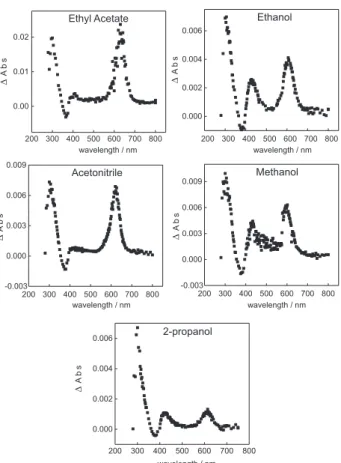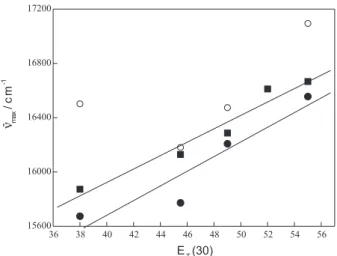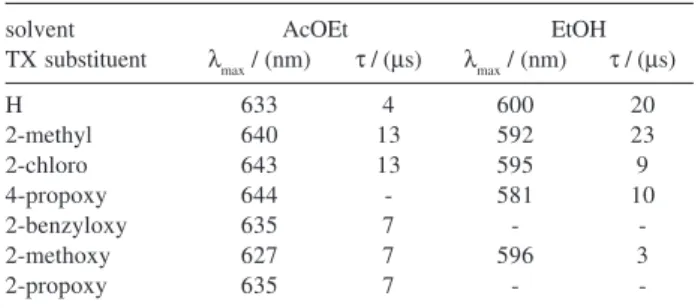Printed in Brazil - ©2006 Sociedade Brasileira de Química 0103 - 5053 $6.00+0.00
Article
*e-mail: neumann@iqsc.usp.br
Dependence of the Thioxanthone Triplet-Triplet Absorption Spectrum with Solvent Polarity
and Aromatic Ring Substitution
Giovana C. Ferreira, Carla C. Schmitt and Miguel G. Neumann*
Instituto de Química de São Carlos, Universidade de São Paulo, CP 780, 13560-970 São Carlos-SP, Brazil
Foram estudadas as absorções triplete-triplete (TT) e de transientes de tioxantonas substituídas e não substituídas em diferentes solventes, com a finalidade de avaliar o efeito do solvente, assim como dos substituintes no anel aromático. Os espectros determinados alguns microssegundos depois da excitação mostram absorções de três transientes principais: o estado triplete (600-650 nm), o radical cetila da tioxantona (~450 nm) e uma superposição de ambos (~300 nm). A quantidade de radicais formados em solventes não-hidroxílicos é muito menor do que em álcoois. O máximo da absorção TT mostra uma boa correlação com o parâmetro ET(30) dos solventes.
The triplet-triplet (TT) and transient absorptions of non-substituted and substituted thioxanthones has been studied in different solvents in order to ascertain the effect of the solvent, as well as the substituents on the aromatic ring. Spectra taken after a couple of µs after the flash show three main transient absorptions due to the triplet state (600-650 nm), the thioxanthone ketyl radical (~450 nm) and an overlap of both (~300 nm). The amount of radicals formed in non hydroxylic solvents is much lower than in alcohols. The maxima of the TT absorption peaks show a good correlation with the ET(30) solvent parameter.
Keywords: thioxanthone, triplet-triplet absorption
Introduction
Due to their role in photochemical and photo-biological reactions, the triplet states of aromatic ketones continue to receive attention from both experimental and theoretical points of view.1-6It is well
known that the polarity of a solvent greatly influences the energies of the electronic states as well as the photophysical properties in aromatic carbonyl systems.7-10 An increase in the solvent polarity results
in the stabilization of ππ* states, as well as a blue shift
of n→ π* transitions, as evidenced by a shift of the
absorption maxima.11,12 Similar shifts have been
observed in the triplet energy levels as a function of solvent polarity.13 Among the aromatic carbonyl
compounds, xanthones and thioxanthones (TX) were extensively studied from a solvent effect point of view. Thioxanthones are efficiently and extensively used as photoinitiators in dentistry resins14-16 and other curing and
photopolymerization systems.17,18 Singlet and triplet
excited states are involved in the photoinitiation.19
This process can be strongly dependent on the polarity of the medium showing a distinct solvent effect on its properties and its triplet-triplet absorption spectra (TTA).1,3 Actually,
the polarity of mixtures used in industrial applications are not well defined but the academic comprehension of polarity effect on the excited states gives support to studies leading to the optimization of the photoinitiators’ efficiency.20,21 In
this work we report on the changes in the transient absorption spectra due to different solvents, as well as substitutions on the aromatic ring of thioxanthones.
Experimental
Ethyl acetate (AcOEt, Mallinckrodt) used in this work was spectroscopic or high performance liquid chromatography grade quality. Thioxanthone (TX) and other solvents, acetonitrile (ACN), methanol (MeOH), ethanol (EtOH) and 2-propanol (PrOH), were obtained from Aldrich. Substituted thioxanthones were provided by Dr. F. Catalina (Instituto de Ciencia y Tecnología de Polímeros, Madrid, Spain).22
were carried out in a Hitachi F-4500 spectrophotometer. Transient decays were determined using an Applied Photophysics laser kinetics spectrometer with a 30 ns excitation pulse at 355 nm using an Nd-YAG laser. The thioxantone solutions were deoxygenated by bubbling oxygen-free nitrogen for 30 min.
Results and Discussion
Figure 1 shows the transient spectra of thioxanthone in different solvents. As can be seen all of them present three different peaks around 330, 400 and 600 nm. In earlier work with thioxanthones, as well as with xanthones, the peaks in the 300 and 600 nm regions were assigned to the triplet-triplet absorption.8,13,23 The
400-450 nm peak is usually attributed to the semireduced form of the ketone, resulting from an H-transfer to the excited triplet.23,24
On the other hand, a remarkable difference can be observed between the spectra taken in hydroxylic and non-hydroxylic solvents. The absorptions observed in the 450 nm region are significantly larger when the reaction is performed in alcohols than in the aprotic solvents ACN and AcOEt.
The absorption maxima and the lifetimes of the transients of TX in different solvents are shown in Table 1.
The solvent effect
The absorption maximum shifts towards shorter wavelengths as the polarity of the medium increases (Figure 3). The solvatochromism of 3TX seems, however,
to be less substantial between nonpolar/polar solvents than between polar/hydroxylic solvents.
As can be seen from Table 1, there is a definite trend of the 600 nm region absorption peak maximum wavelengths when the polarity of the solvents is changed. This can be observed clearly in Figure 3, where the energies of T-T absorption peaks (defined in terms of wavenumbers) are plotted against the ET(30) parameter, indicating the influence of the solvent on the behaviour of the triplet state of thioxanthones.
Following the procedure suggested for xanthones,3,25
some of these peaks were deconvoluted into two components that should correspond to T-T absorptions of the nπ* and ππ* triplet states. The maxima for these differentiated absorption peaks are indicated in the last column of Table 1 and also plotted in Figure 3. A rather good correlation is obtained with the wavelengths corresponding to the lower energy transition, showing Figure 1. Transient absorption spectra of TX in different solvents taken
2.3 µs after excitation.
Figure 2. Triplet absorption spectra of TX in different solvents in the 600 nm region, taken 2 µs after excitation.
Table 1. Triplet state maximum absorption and lifetimes of TX in various solvents
Solvent ET (30) λmax ν / (cm-1) τ / (µs) λ deconv.
AcOEt 38 630 15 900 4.2 606 – 638
ACN 45.5 620 16 100 4.0 618 – 634
MeOH 55 600 16 300 19.8 585 – 604
EtOH 52 602 16 600 9.9
PrOH 49 614 16 700 6.8 607 – 617
a similar dependence with the solvents. This transition corresponds probably to the excitation of the 3ππ* state
for the more polar solvents (alcohols and ACN). Therefore, it seems quite reasonable to attribute basically a ππ* character to the lower lying triplet state. These propositions are in accord with the orbital energy Scheme shown in Figure 4.
The lifetimes of the transients also show a different behaviour in hydroxylic and non-hydroxylic solvents. Whereas in alcohols the 600 nm absorption is rather long-lived (6-20 µs) in AcOEt and ACN it is around 4 µs. This tendency is similar to that found for xanthones,25 although the values for the lifetimes are
different.
The radical formation
An important issue related to the photochemistry of thioxanthones (similar to xanthones and other ketones) is the ability to abstract hydrogen and form radicals.8,26 These radicals can be observed from the
peaks appearing in the 400-450 nm region.24 As can be
seen from Figure 1, the amount of radicals formed in AcOEt is quite smaller than that formed in alcohols, whereas in ACN the absorption in this region is
practically negligible. Similar conclusion can also be reached by comparing the decays of the transient absorption at 340 nm.
In this region there is an overlap of the absorption due to the triplet state and the radicals. Thus, as the amount of radicals formed in AcOEt and ACN is relatively small (if any), the time evolution of the absorption at that wavelength will be practically a mere decay of the triplet state (see Figure 4 and Table 2). On the other hand, for EtOH and PrOH, there is an initial in-grow of the absorption, followed by a much slower decrease. This is due to the initial fast H-abstraction forming a radical that absorbs in the same region, and the slow decrease is ascribed to the radical recombination reaction. The reaction in methanol, represents an intermediate case, in which the hydrogen abstraction will be quite slower due to the higher energy of the C-H bond.
It is generally assumed that the radicals formed by H-abstraction from the solvent involve the nπ* triplet state.3
Conversely, the 3ππ* states are considered to be less reactive
towards H-transfer.8,25,27 On the other hand, if both
Figure 3. Correlation of the wavenumber of the maximum of the TT absorption with the ET(30) parameter. () peak maximum and maxima of deconvoluted peak (z) low energy transition, ({) high energy transi-tion.
Figure 4. Orbital energy diagram for the excited states of TX in aprotic and protic solvents.
Figure 5. Time evolution of the 340-nm transient of TX in different sol-vents.
Table 2. Lifetimes of the absorption transients of TX in several solvents
λ region AcOEt ACN MeOH EtOH 2-PrOH
triplet states are considered as a mixture of both states
T1 = aπ×(ππ*) + an×(nπ*) T2 = bπ×(ππ*) + bn×(nπ*)
where the a and b coefficients represent the weight of the pure (ππ*) and (nπ*) states to each actual triplet, it could be considered that there is always a contribution of the nπ* state in the lower lying triplet. This would explain the H-abstraction in the case of alcohols, were the lower lying triplet is a ππ* state. Additionally, as stated in basic quantum mechanics principles, the extend of the mixing of two states is inversely proportional to the energy difference between those states. As can be seen from Table 1, the separation between the two deconvoluted states in the alcohols is rather larger in methanol than in propanol, justifying the larger lifetime for the former. Thus, the faster H-abstraction rate from 2-propanol as compared to methanol has a two-fold explanation. On one side, the triplet state in the former solvent will have a larger
nπ* character in addition to the lower activation energy for a secondary H abstraction.
The shorter lifetimes found for the decays of the triplets in non-hydroxylic solvents ACN and AcOEt are also believed to be due to the concurrence of two different factors. On one side, the T1 states have mainly nπ* character and lie nearer to the So (ππ) ground state, facilitating the decay to this state. Additionally, due to spin-orbital coupling 3nπ*→ 1ππ transitions are more
probable than 3ππ*→1ππ.28
Substitution effects
The lifetimes and absorption maxima of the triplet transients of substituted thioxanthones are shown in Table 3. Two general features can be deduced from there. On one side, the maxima of the TT absorption peak are displaced to longer wavelengths in ethyl acetate when compared with methanol, independently of the substituents. This effect correlates well with the tendency shown in Figure 3. Also, it was observed that there can be found a certain logic in the triplet lifetimes when the substituted thioxanthones are dissolved in ethyl acetate. The lifetimes for the compounds with ether groups have lifetimes of the order of 7 µs, whereas for other substitutions it increases to 13 µs.
It is also noteworthy that not such a tendency is found for ethanol solutions, possibly due to the fact that to account for the lifetimes one should take into account not only the effect of the triplet stabilization by the hydroxylic
solvent, but also the effect that the substitutions might have on the H-abstraction rates.
Conclusions
The absorption spectra of thioxanthone and substituted thioxanthones transients in various solvents show three maxima. One in the 600-650 nm region, assigned to the triplet-triplet absorption, another at 400-450 nm corresponding to the ketyl radical formed by an hydrogen abstraction, and a shorter wavelength peak around 300 nm which is a mixture of the semireduced radical and a triplet-triplet absorption. The radical absorption is very low in AcOEt and negligible in ACN due to the lack of easily abstractable hydrogens in these solvents.
A good correlation is found between the solvent ET(30) parameter and the energy of the triplet-triplet absorption. Furthermore, when deconvoluting the 650 nm peak, two peaks can be obtained which are assigned to the 3nπ* and 3ππ* transitions. The same parameter also
correlates quite well with the energies corresponding to the 3ππ* transition.
Substitution of thioxanthones also shows a dependence of the triplet-triplet absorption peak with the solvent. No easy correlation can be found between the lifetimes of the triplets and the substituents due to the concurrent effects of solvent stabilization and hydrogen abstraction which are influenced differently by substitution on the aromatic ring.
Acknowledgments
Financial support by FAPESP, Brazil (Proc. 03/07770-4), is gratefully acknowledged. G.C.F. thanks CNPq, Brazil, for a graduate fellowship.
References
1. Morlet-Savary, F.; Ley, C.; Jacques, P.; Wieder, F.; Fouassier, J. P.; J. Photochem. Photobiol., A 1999, 126, 7.
Table 3. Maximum wavelengths and triplet lifetimes of substituted thioxanthones in ethyl acetate and ethanol
solvent AcOEt EtOH
TX substituent λmax / (nm) τ / (µs) λmax / (nm) τ / (µs)
H 633 4 600 20
2-methyl 640 13 592 23
2-chloro 643 13 595 9
4-propoxy 644 - 581 10
2-benzyloxy 635 7 -
-2-methoxy 627 7 596 3
-2. Allonas, X.; Ley, C.; Bibaut, C.; Jacques, P.; Fouassier, J. P.;
Chem. Phys. Lett.2000, 322, 483.
3. Ley, C.; Morlet-Savary, F.; Fouassier, J. P.; Jacques, P.; J.
Photochem. Photobiol., A 2000, 137, 87.
4. Okano, L. T.; Barros, T. C.; Chou, D. T. H.; Bennet, A. J.; J.
Phys. Chem. B2001, 105, 2122.
5. Satzger, H.; Schmidt, B.; Root, C.; Zinth, W.; Fierz, B.; Krieger, F.; Kiefhaber, T.; Gilch, P.; J. Phys. Chem. A2004, 108, 10072. 6. Goez, M.; Hussein, B.; Hussein, M.; Phys. Chem. Chem. Phys.
2004, 6, 5490.
7. Dalton, J. C.; Mongomery, F. C.; J. Am. Chem. Soc.1974, 96, 6230.
8. Scaiano, J. C.; J. Am. Chem. Soc.1980, 102, 7747.
9. Ley, C.; Morlet-Savary, F.; Jacques, P.; Fouassier, J. P.; Chem.
Phys.2000, 255, 335.
10. Encinas, M. V.; Rufs, A. M.; Corrales, T.; Catalina, F.; Peinado, C.; Schmith, K.; Neumann, M. G.; Allen, N. S.; Polymer2002,
43, 3909.
11. Cavaleri, J. J.; Prater, K.; Bowman, R. M.; Chem. Phys. Lett.
1996, 259, 495.
12. Neumann, M. G.; Gehlen, M. H.; Encinas, M. V.; Allen, N. S.; Corrales, T.; Peinado, C.; Catalina, F.; J. Chem. Soc., Fraday
Trans.1997, 93, 1517.
13. Allen, N. S.; Salleh, N. G.; Edge, M.; Shah, M.; Ley, C.; Morlet-Savary, F.; Fouassier, J. P.; Catalina, F.;Green, A.; Navaratnam, S.; Parsons, B. J.; Polymer1999, 40, 4181.
14. Hayakawa, T.; Horie, K.; Dent. Mater.1992, 8, 351. 15. Nakanuma, K.; Hayakawa, T.; Tomita, T.; Muneyoshi, Y.; Dent.
Mat.1998, 14, 281.
16. Hayakawa, T.; Kikutake, K.; Nemoto, K.; Dental Mater. J.1999,
18, 324.
17. Anderson, D. G.; Davidson, R. S.; Elvery, J. J.; Polymer1996,
37, 2477.
18. Corrales, T.; Peinado, C.; Catalina, F.; Neumann, M. G.; Allen, N. S.; Rufs, A. M.; Encinas, M. V.; Polymer2000, 41, 9103. 19. Jacques, P.; Burget, D.; Allonas, X.; Fouassier, J. P.; Chem.
Phys. Lett.1994, 227, 26.
20. Abdullah, K. A.; Kemp, T. J.; J. Photochem.1986, 32, 49. 21. Burget, D.; Jacques, P.; Chem. Phys. Lett.1998, 291, 207. 22. Catalina, F.; Peinado, C.; Madruga, E. L.; Sastre, R.; J. Polym.
Sci. A: Polym. Chem.1990, 28, 967.
23. Allen, N. S.; Catalina, F.; Green, P. N.; Green, W.A.; Eur.
Polym. J.1986, 22, 871.
24. Allen, N. S.; Catalina, F.; Green, P. N.; Green, W.A.; Eur.
Polym. J.1986, 22, 347.
25. Evans, C. H.; Prud’homme, N.; King, M.; Scaiano, J. C.; J.
Photochem. Photobiol. A: Chem. 1999, 121, 105.
26. Corrales, T.; Catalina, F.; Peinado, C.; Allen, N. S.; Rufs, A. M.; Bueno, C.; Encinas, M.; Polymer2002, 43, 4591. 27. Wagner, P. J.; Kemppainen, A. E.; Schott, H. N.; J. Am. Chem.
Soc.1973, 95, 5604.
28. El-Sayed, M. A.; Accounts Chem. Res.1971, 23, 23.
Received: February 17, 2006 Published on the web: June 29, 2006


